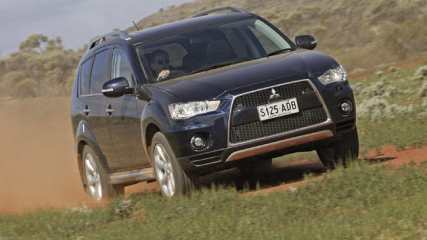Used Mitsubishi Outlander review: 2003-2004
By Graham Smith · 02 Jul 2009
It took Mitsubishi a while to get into the on-road offroader market, but when it did it did so in its usual competent way with the Outlander. The compact offroader market has been the biggest growth segment on the local scene in recent times so it was only natural that Mitsubishi came up with a contender.The first effort, the Pajero iO wasn’t well accepted. It was well credentialed to go offroad, possibly the best in the class, but an offroad capability doesn’t count when it’s only going to be used to take the kids to school and pick up the groceries.What does matter in this class of town cars is size and the iO was too small, and it was also a little too uncouth for town use. The Outlander was Mitsubishi’s next attempt to break into the market and it was a much better effort.MODEL WATCH Like all compact SUVs the Outlander looked like an offroader, but that’s about where the similarity ended. With its high ride height, and all-wheel drive, it could handle dirt roads and smooth bush tracks with aplomb, but it wasn’t meant to plunge too deep into the real Outback.The reality is that, like all SUVs, the Outlander was a family wagon and it was a capable one in that role. Looked at from most angles the Outlander seems a middle of the road, conventional Japanese SUV, but then you spot the front and wonder if the designer was having a bad hair day.Either that or the guy who chose the name really meant to call it ‘Outlandish’ and got it wrong. The front is just appalling. You really should warn to neighbors you’re buying one so they can put the dog away before you drive it home.Under the prominent snout lies a modest 2.35-litre single overhead camshaft fuel-injected four-cylinder engine that puts out 100 kW at 5000 revs and 205 Nm at 2500 revs. The engine was upgraded with Mitsubishi’s MIVEC variable valve timing system in 2004 when the power jumped to 120 kW at 5750 revs and 220 Nm at 4000 revs to give it a little more punch.It only came with a four-speed auto, which was a smooth unit and perfectly suited to its intended use around town. The Outlander didn’t have a low-range like any serious offroader does. Instead it had a viscous coupling with drive split 50 per cent front and rear with conventional diffs at both ends, and no traction control. As such its off-road ability is limited. There’s little wheel travel, no low-range, no limited-slip diff, no traction control and no underbody protection. On the black top it’s another matter. It’s quiet, comfortable and quite refined.The Outlander has fully independent suspension front and back, with struts at the front and a multi-link layout in the rear. The tuning is well sorted so it can be driven with confidence on all types of roads. On the highway the engine can be found wanting for grunt when you need to overtake, but apart from that it’s quite a smooth unit. Inside, the Outlander is quite roomy, it’s the sort of room a family wants.The LS opened the bidding and had a long list of standard equipment including cloth trim, air-conditioning, power windows, tilt column, cruise, power mirrors, CD player, immobilizer, remote central locking. Buy the XLS and you got leather, sunroof, six speakers and a cargo cover.IN THE SHOP There is no real intelligence on problems with the Outlander; it appears to be quite robust and reliable, although it is early days yet with the early cars now only just past the 50,000 km mark. But based on Mitsubishi’s generally good record of reliability it is fair to assume it will continue to be reliable in the longer term.The Outlander isn’t designed to beat around the bush so look for signs of offroad use. Look over, under, inside and out for stone and rock impact damage to panel work and underbody equipment, and dust intrusion in door openings and hardware etc. Walk away if you suspect it’s been used off the beaten track. Check for a service record to make sure it’s been maintained from new.IN A CRASH All models had seat belts with pretensioners and dual front airbags, while other models higher up the pecking order also had front side airbags as well. Well-tuned suspension with ABS brakes and EBD electronic brakeforce distribution aided safety.FUEL ECONOMY On average you could expect to get 12-13 L/100 km from the Outlander, which appears a little thirstier than its main rivals.OWNERS SAY Len Gemelli bought a later Outlander VR-X in 2005 when he wanted to downsize from a Mitsubishi Challenger he’d done 200,000 km in without any trouble, and says he’s extremely happy with its comfort, performance and economy in the 45,000 km it has done. The only downside is the Sat Nav system, which due to an issue with Mitsubishi and Eurovox cannot be upgraded.Bruce Gill bought his Outlander in December 2005, when Mitsubishi was doing a drive-away special deal. Bruce says it’s not a performance car, but it is a great package. The MIVEC engine moves it along as well as it needs to, and it’s comfortable and quiet. For the first time he says he really appreciated the full-time all-wheel drive on a snow and ice covered road to the ski resorts It hasn’t missed a beat, and he’s getting around 10.5 L/100 km on a mix of mostly country and some around town driving. Doing 100-110 km/h on highways, it’s comfortable and quiet. His only real criticism is the relatively small load area and slightly odd style at the rear.LOOK FOR • challenging looks• very roomy interior• modest performance• limited offroad capability• robust and reliableTHE BOTTOM LINE Reliable and roomy, it’s one of the better SUVs if you can get used to the looksRATING 70/100

